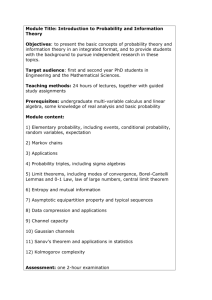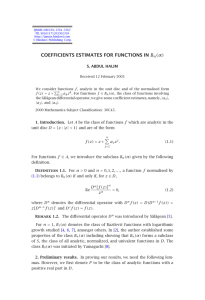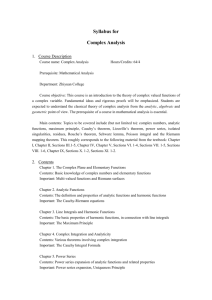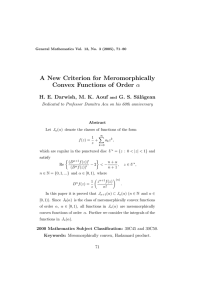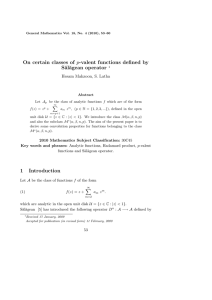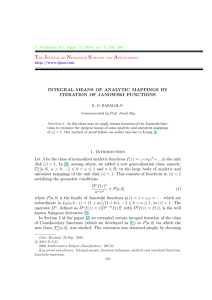Document 10449576
advertisement
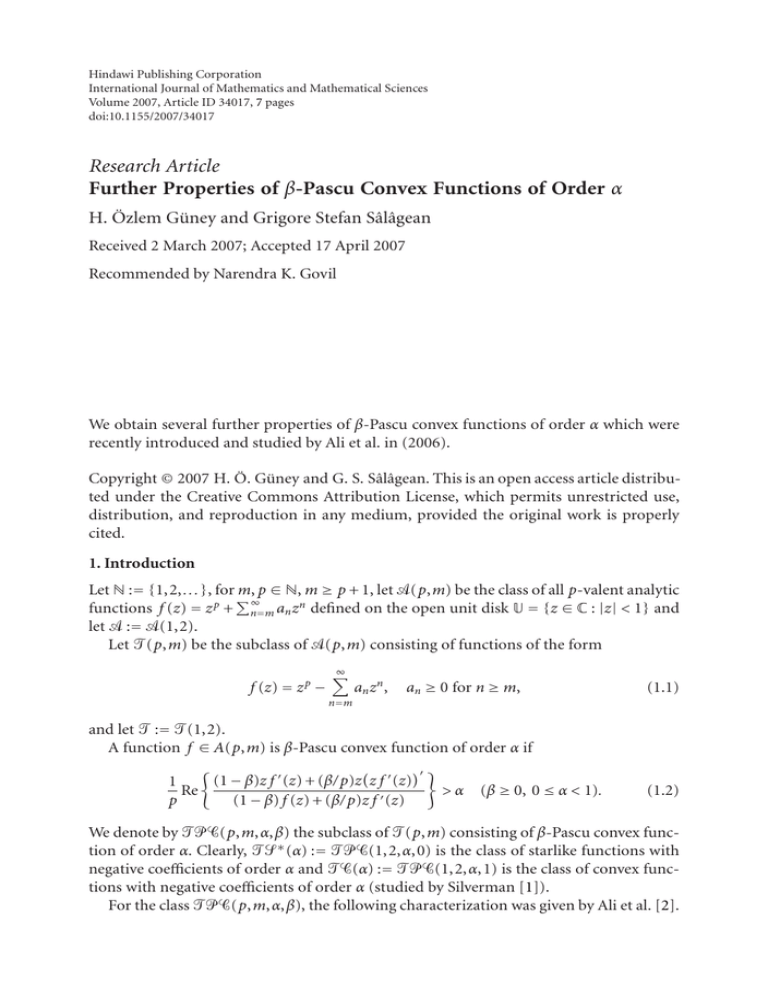
Hindawi Publishing Corporation
International Journal of Mathematics and Mathematical Sciences
Volume 2007, Article ID 34017, 7 pages
doi:10.1155/2007/34017
Research Article
Further Properties of β-Pascu Convex Functions of Order α
H. Özlem Güney and Grigore Stefan Sâlâgean
Received 2 March 2007; Accepted 17 April 2007
Recommended by Narendra K. Govil
We obtain several further properties of β-Pascu convex functions of order α which were
recently introduced and studied by Ali et al. in (2006).
Copyright © 2007 H. Ö. Güney and G. S. Sâlâgean. This is an open access article distributed under the Creative Commons Attribution License, which permits unrestricted use,
distribution, and reproduction in any medium, provided the original work is properly
cited.
1. Introduction
m, p ∈ N, m ≥ p + 1, let Ꮽ(p,m) be the class of all p-valent analytic
Let N := {1,2,... }, for n
functions f (z) = z p + ∞
n=m an z defined on the open unit disk U = {z ∈ C : |z | < 1} and
let Ꮽ := Ꮽ(1,2).
Let ᐀(p,m) be the subclass of Ꮽ(p,m) consisting of functions of the form
f (z) = z p −
∞
an z n ,
an ≥ 0 for n ≥ m,
(1.1)
n =m
and let ᐀ := ᐀(1,2).
A function f ∈ A(p,m) is β-Pascu convex function of order α if
(1 − β)z f (z) + (β/ p)z z f (z)
1
Re
p
(1 − β) f (z) + (β/ p)z f (z)
> α (β ≥ 0, 0 ≤ α < 1).
(1.2)
We denote by ᐀ᏼᏯ(p,m,α,β) the subclass of ᐀(p,m) consisting of β-Pascu convex function of order α. Clearly, ᐀∗ (α) := ᐀ᏼᏯ(1,2,α,0) is the class of starlike functions with
negative coefficients of order α and ᐀Ꮿ(α) := ᐀ᏼᏯ(1,2,α,1) is the class of convex functions with negative coefficients of order α (studied by Silverman [1]).
For the class ᐀ᏼᏯ(p,m,α,β), the following characterization was given by Ali et al. [2].
2
International Journal of Mathematics and Mathematical Sciences
Lemma 1.1. Let the function f be defined by (1.1). Then f is in the class ᐀ᏼᏯ(p,m,α,β) if
and only if
∞
(n − pα) (1 − β)p + βn an ≤ p2 (1 − α).
(1.3)
n =m
The result is sharp.
Lemma 1.2. Let f (z) be given by (1.1). If f ∈ ᐀ᏼᏯ(p,m,α,β), then
an ≤
p2 (1 − α)
(n − pα) (1 − β)p + βn
(1.4)
with equality only for functions of the form
fn (z) = z p −
p2 (1 − α)
zn .
(n − pα) (1 − β)p + βn
(1.5)
Many interesting properties such as coefficient estimate and distortion theorems for
the class ᐀ᏼᏯ(p,m,α,β) were given by Ali et al. [2]. In the present sequel to these earlier
works, we will derive several interesting properties and characteristic of the δneighborhood associated with the class ᐀ᏼᏯ(p,m,α,β).
2. Integral properties of the class ᐀ᏼᏯ(p,m,α,β)
We recall the following definition of integral operator before we give integral properties
of the class ᐀ᏼᏯ(p,m,α,β).
Let Ᏽc : ᐀(p,m) → ᐀(p,m) be integral operator defined by g = Ᏽc ( f ), where c ∈
(− p, ∞), f ∈ ᐀(p,m) and
g(z) =
c+ p
zc
z
0
t c−1 f (t)dt.
(2.1)
We note that if f ∈ ᐀(p,m) is a function of the form (1.1), then
g(z) = Ᏽc ( f )(z) = z p −
∞
c+ p
n =m c + n
an zn .
(2.2)
Theorem 2.1. Let p,m ∈ N, m ≥ p + 1, α ∈ [0,1), β ∈ [0, ∞), and c ∈ (− p, ∞). If f ∈
᐀ᏼᏯ(p,m,α,β) and g = Ᏽc ( f ), then g ∈ ᐀ᏼᏯ(p,m,λ,β), where
λ = λ(p,m,α,c) = 1 −
(1 − α)(c + p)(m − p)
(m − pα)(c + m) − (1 − α)(c + p)p
(2.3)
and α < λ. The result is sharp.
Proof. From Lemma 1.1 and (2.2), we have g ∈ ᐀ᏼᏯ(p,m,λ,β) if and only if
∞
(n − pλ) (1 − β)p + βn (c + p)
an ≤ 1.
p2 (1 − λ)(c + n)
n =m
(2.4)
H. Ö. Güney and G. S. Sâlâgean 3
We find the largest λ such that (2.4) holds. We note that the inequalities
(n − pλ) (1 − β)p + βn (c + p) (n − pα) (1 − β)p + βn
≤
p2 (1 − λ)(c + n)
p2 (1 − α)
(2.5)
imply (2.4), because f ∈ ᐀ᏼᏯ(p,m,α,β) and satisfy (1.3). But inequalities (2.5) are
equivalent to
(n − pλ)(c + p) (n − pα)
≤
.
(1 − λ)(c + n)
(1 − α)
(2.6)
Since (n − pα) > p(1 − α) and c + n > c + p, we obtain λ ≤ λ(p,n,α,c), where
λ(p,n,α,c) =
(n − pα)(c + n) − (1 − α)(c + p)n
.
(n − pα)(c + n) − (1 − α)(c + p)p
(2.7)
Now we show that λ(p,n,α,c) is an increasing function of n, n ≥ m. Indeed,
λ(p,n,α,c) = 1 − (1 − α)(c + p)E(p,n,α,c),
(2.8)
where
E(p,n,α,c) =
(n − p)
,
(n − pα)(c + n) − (1 − α)(c + p)p
(2.9)
and λ(p,n,α,c) increases when n increases if and only if E(p,n,α,c) is a strictly decreasing
function of n.
Let h(x) = E(p,x,α,c), x ∈ [m, ∞) ⊂ [p + 1, ∞), we have
h (x) = − (x − p)2
(x − pα)(c + x) − (1 − α)(c + p)p
2 < 0.
(2.10)
We obtained
λ = λ(p,m,α,c) ≤ λ(p,n,α,c),
n ≥ m.
(2.11)
The result is sharp because
Ᏽc f α = f λ ,
(2.12)
where
fα (z) = z p −
p2 (1 − α)
zm ,
(m − pα) (1 − β)p + βm
fλ (z) = z p −
p2 (1 − λ)
zm
(m − pλ) (1 − β)p + βm
(2.13)
are extremal functions of ᐀ᏼᏯ(p,m,α,β) and ᐀ᏼᏯ(p,m,λ,β), respectively, and λ =
λ(p,m,α,c).
4
International Journal of Mathematics and Mathematical Sciences
Indeed, we have
Ᏽc fα (z) = z p −
p2 (1 − α)(c + p)
zm .
(m − pα) (1 − β)p + βm (c + m)
(2.14)
We deduce
p2 (1 − λ) p2 (1 − α)(c + p)
=
,
(m − pλ) (m − pα)(c + m)
(2.15)
and this implies (2.14).
From λ = 1 − (1 − α)(c + p)(m − p)/((m − pα)(c + m) − (1 − α)(c + p)p) we obtain λ <
1 and also λ > α. Indeed,
λ − α = (1 − α) 1 −
(c + p)(m − p)
(m − pα)(c + m) − (1 − α)(c + p)p
(m − pα)(m − p)
> 0.
= (1 − α)
(m − pα)(c + m) − (1 − α)(c + p)p
(2.16)
3. Integral means inequalities for the class ᐀ᏼᏯ(p,m,α,β)
An analytic function g is said to be subordinate to an analytic function f (written g ≺
f ) if g(z) = f (w(z)), z ∈ U, for some analytic function w with |w(z)| ≤ |z|. In 1925,
Littlewood [3] proved the following subordination result which will be required in our
present investigation.
Lemma 3.1. If f and g are analytic in U with g ≺ f , then
2π
0
iθ δ
g re dθ ≤
2π
0
iθ δ
f re dθ,
(3.1)
where δ > 0, z = reiθ , and 0 < r < 1.
Applying Lemmas 1.1 and 3.1, we prove the following.
Theorem 3.2. Let δ > 0. If f ∈ ᐀ᏼᏯ(p,m,α,β) and fm (z) = z p − (p2 (1 − α)/(m− pα)[(1 −
β)p + βm])zm , then for z = reiθ and 0 < r < 1,
2π
0
iθ δ
f re dθ ≤
2π
0
iθ δ
fm re dθ.
(3.2)
Proof. Let
f (z) = z p −
∞
an z n ,
an ≥ 0, n ≥ m,
n =m
p2 (1 − α)
zm ,
fm (z) = z −
(m − pα) (1 − β)p + βm
p
(3.3)
H. Ö. Güney and G. S. Sâlâgean 5
then we must show that
δ
2π 2π ∞
n
−p
1 −
1 −
an z dθ ≤
0
0 n =m
p2 (1 − α)
z
(m − pα) (1 − β)p + βm
δ
m− p dθ.
(3.4)
By Lemma 3.1, it suffices to show that
1−
∞
p2 (1 − α)
zm− p .
(m − pα) (1 − β)p + βm
(3.5)
p2 (1 − α)
w(z)m− p .
(m − pα) (1 − β)p + βm
(3.6)
an z n − p ≺ 1 −
n =m
Set
∞
1−
an z n − p = 1 −
n =m
From (3.6) and (1.3), we obtain
∞
n
−p
w(z)m− p = (m − pα) (1 − β)p + βm a
z
n
p2 (1 − α)
n =m
∞
m− p (n − pα) (1 − β)p + βn
≤ z
an ≤ zm− p ≤ |z|.
2 (1 − α)
p
n =m
(3.7)
This completes the proof of the theorem.
The proof for the first derivative is similar.
Theorem 3.3. Let δ > 0. If f ∈ ᐀ᏼᏯ(p,m,α,β) and fm (z) = z p − (p2 (1 − α)/(m − pα)[(1 −
β)p + βm])zm , then for z = reiθ and 0 < r < 1,
2π
0
iθ δ
f re dθ ≤
2π
0
f (reiθ δ dθ.
m
(3.8)
Proof. It suffices to show that
1−
∞
n
n =m p
an z n − p ≺ 1 −
mp(1 − α)
zm− p .
(m − pα) (1 − β)p + βm
(3.9)
This follows because
∞
(n − pα)(1 − β)p + βn
n− p w(z)m− p = z
a
n
p2 (1 − α)
n =m
n− p
≤ |z|
∞
(n − pα) (1 − β)p + βn
an ≤ |z|n− p ≤ |z|.
p2 (1 − α)
n =m
(3.10)
6
International Journal of Mathematics and Mathematical Sciences
4. Neighborhoods of the class ᐀ᏼᏯ(p,m,α,β)
For f ∈ ᐀(p,m) and γ ≥ 0, Frasin [4] defined
q
Mγ ( f ) = g ∈ ᐀(p,m) : g(z) = z p −
∞
bn zn ,
n =m
∞
nq+1 an − bn ≤ γ ,
(4.1)
n =m
which was called q-γ-neighborhood of f . So, for e(z) = z, we see that
q
Mγ (e) = g ∈ ᐀(p,m) : g(z) = z p −
∞
n =m
bn zn ,
∞
nq+1 bn ≤ γ ,
(4.2)
n =m
where q is a fixed positive integer. Note that Mγ0 ( f ) ≡ Nγ ( f ) and Mγ1 ( f ) ≡ Mγ ( f ). Nγ ( f )
is called a γ-neighborhood of f by Ruscheweyh [5] and Mγ ( f ) was defined by Silverman
[6].
Now, we consider q-γ-neighborhood for function in the class ᐀ᏼᏯ(p,m,α,β).
Theorem 4.1. Let
γ=
mq+1 p2 (1 − α)
,
(m − pα) (1 − β)p + βm
(4.3)
q
then ᐀ᏼᏯ(p,m,α,β) ⊂ Mγ (e).
Proof. If f ∈ ᐀ᏼᏯ(p,m,α,β), then
∞
nq+1 an ≤
n =m
mq+1 p2 (1 − α)
= γ.
(m − pα) (1 − β)p + βm
q
This gives that ᐀ᏼᏯ(p,m,α,β) ⊂ Mγ (e).
(4.4)
Putting p = 1, m = 2 and β = 0 in Theorem 4.1, we have the following.
q
Corollary 4.2. ᐀∗ (α) ⊂ Mγ (e), where γ = 2q+1 (1 − α)/(2 − α).
Putting p = 1,m = 2, and β = 1 in Theorem 4.1, we have the following.
q
Corollary 4.3. ᐀Ꮿ(α) ⊂ Mγ (e), where γ = 2q (1 − α)/(2 − α).
References
[1] H. Silverman, “Univalent functions with negative coefficients,” Proceedings of the American
Mathematical Society, vol. 51, no. 1, pp. 109–116, 1975.
[2] R. M. Ali, M. H. Khan, V. Ravichandran, and K. G. Subramanian, “A class of multivalent functions with negative coefficients defined by convolution,” Bulletin of the Korean Mathematical
Society, vol. 43, no. 1, pp. 179–188, 2006.
[3] J. E. Littlewood, “On inequalities in the theory of functions,” Proceedings of the London Mathematical Society, vol. 23, no. 1, pp. 481–519, 1925.
[4] B. A. Frasin, “Family of analytic functions of complex order,” Acta Mathematica. Academiae
Paedagogicae Nyı́regyháziensis, vol. 22, no. 2, pp. 179–191, 2006.
H. Ö. Güney and G. S. Sâlâgean 7
[5] S. Ruscheweyh, “Neighborhoods of univalent functions,” Proceedings of the American Mathematical Society, vol. 81, no. 4, pp. 521–527, 1981.
[6] H. Silverman, “Neighborhoods of classes of analytic functions,” Far East Journal of Mathematical
Sciences, vol. 3, no. 2, pp. 165–169, 1995.
H. Özlem Güney: Department of Mathematics, Faculty of Science and Arts, University of Dicle,
21280 Diyarbakir, Turkey
Email address: ozlemg@dicle.edu.tr
Grigore Stefan Sâlâgean: Faculty of Mathematics and Computer Science, Babes-Bolyai University,
1 M. Kogalniceanu Street, 400084 Cluj-Napoca, Romania
Email address: salagean@math.ubbcluj.ro

